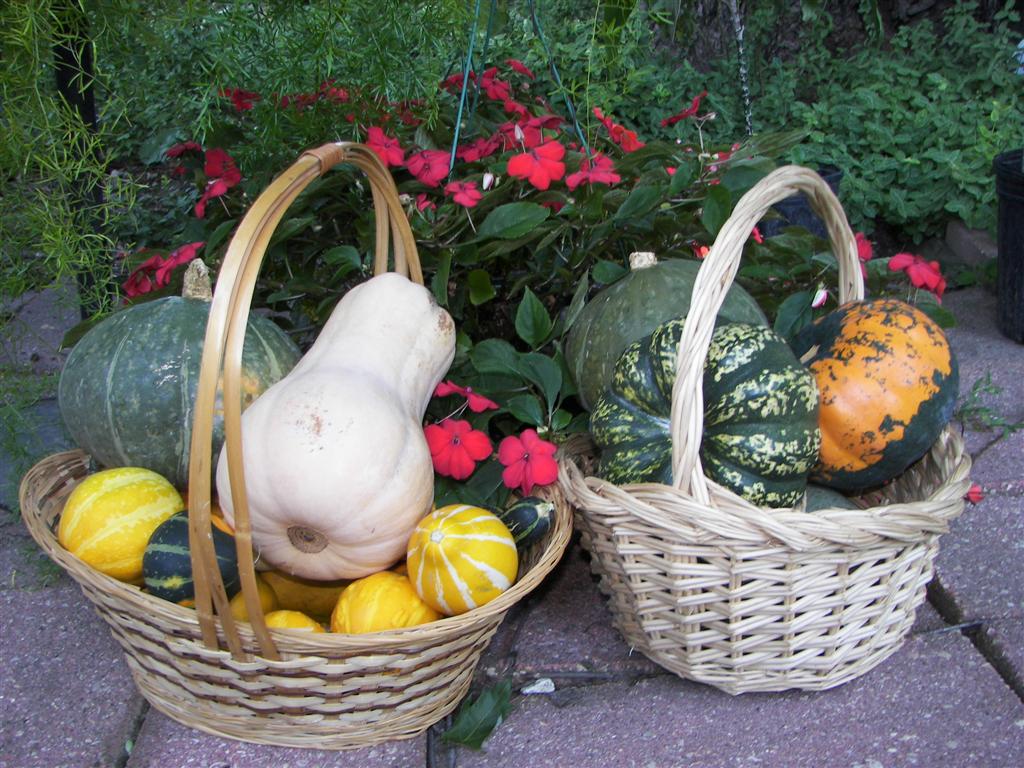Autumn is the time of year for gathering and organizing.
In oriental medicine METAL is the element.
The LUNGS AND LARGE INTESTINE are the organs most active at this time of the year, and they are associated with the functions of exchange and elimination.
COLOR: white
BODY FLUIDS: mucus
PARTS OF THE BODY: shoulders
ORGAN: nose
SENSITIVITY: smell
SYSTEM: respiratory- eliminator
TISSUE: skin
FLAVOR: spicy- pungent
GRAIN: rice
BEANS: soybeans, tofu, navy beans
VEGETABLES: white onion, cabbage, turnips, celery, radish, cauliflower
FRUIT: pear
ANIMAL FOOD: cod, flounder, haddock, turkey, beef
MOODS:
- POSITIVE: creative, understanding, orderly, social, enthusiastic
- NEGATIVE: melancholy, worried, grief, depressed, territorial
LUNGS
The lungs are the source of our life force, the gateway to take in prana....the spiritual force.
The lungs (bronchi + trachea) control KI = breath & energy.
Ki is absorbed through inhalation of the air.
The KI of liquid and solid food from the digestion passes to the lungs to unite with the KI of the air to form the true Ki of the body.
KI controls the exterior of the body while blood controls the interior.
Respiration is closely related to the brain functions and has a profound influence on a person's state of mind and because the body-mind-spirit are one, it influences the entire being.
Must people that come to me for treatments have forgotten how to breathe because of the tension in the life style that they conduct.
If we observe an infant at birth, with each breath his abdomen rises (the child has not encountered stress in his life yet, so he is breathing naturally). Most people under stress tend to tighten there abdomen and so they breathe only with the chest. This way of breathing is incorrect, because only ½ of the lungs are filled with air, so less oxygen is available into the body. By not using abdominal breathing with each breath, the diaphragm is not moving. It is very important for the person that wants to regain their health to do abdominal breathing. In fact with each breath the diaphragm massages the interior organs, while the entire body gets more oxygen.
The lungs and large intestine are closely associated to the skin the pores, the nose, the throat, the complexion, the white of the eyes, respiration, and the anus.
DISORDERS of the lungs:
Difficulty in breathing, shortness of breath, bronchitis, asthma, pneumonia, common cold, whooping cough, soar throat, swollen and painful tonsils and neck, tonsillitis, laryngitis, chest pain, pain in the shoulders, swelling and pain in the elbow, pain and numbness in the arms, pain and paralysis of the wrists, facial paralysis and amnesia.
In ORIENTAL FACIAL DIAGNOSIS we can see the conditions of the lungs by observing the:
CHEEK COLOR:
- Pale = Anemic condition could indicate tuberculosis.
- Red or pink = When the body is at rest, not being exposed to cold weather or exercising, this color indicates abnormal expansion of blood capillaries and hyperactive conditions of the lungs caused by excessive sugar or liquid intake; also excessive drugs, spices and stimulants.
- White = Accumulation of fat and mucus caused by high consumption of dairy foods (soft cheese, milk, cream, yogurt, ice cream), tofu, soybeans, and refined flour products.
- Purple = A large discoloration indicates that the lungs are are very weak due to a high intake of sugar, chemicals, and/or drugs. A small discoloration indicates blood stagnation or hemorrhage in the lungs.
PIMPLES on the skin are eliminations of excessive fat and mucus due to excessive consumption of animal foods, dairy, oils, and/or sugar. The fat and mucus is expelled because there is too much of an accumulation in the lungs.
- WHITE PIMPLES: milk and sugar
- YELLOW: cheese poultry and eggs
THE SKIN:
- Oily = Excessive intake of oil and fat, disorders of the fat metabolism, and overeating in general.
- Dark spots = Fat and mucus accumulations are sometimes a sign of the beginning of a cyst or tumor in the lungs.
- Freckles = Elimination of an excessive amount of refined sugar, honey, fruit, and milk that is causing harm to the respiratory track.
- Hairs = Fine small silver hair indicate over-consumption of dairy. Dark hair is a sign of over-consumption of read meat.
- Beauty marks = Indicate past fever.
- Moles = An elimination of excessive protein, from overeating especially fat and carbohydrates.
THE EYES:
- Red spots= Blood clots or circulatory stagnation in the lungs.
- Bloodshot= Caused by excess sugar/sweets-yin food and drinks
- The white =(sclera)
- Right eye= right lung.
- Left eye= Left lung.
- The outside upper quadrant of each eye shows the condition of the lungs.
LARGE INTESTINE
The large intestine is composed of seven sections: cecum, ascending colon, transverse colon, descending colon, sigmoid colon, rectum and the anal canal. A mucus membrane covers the inner wall of the colon.
The functions of this organ can be simplified in three parts:
1. Absorb water and nutrients through the intestinal walls.
2. Expel solid waste products from the body.
3. Synthesize important vitamins.
We do not realize that if our entire intestinal track was stretched out, it would be as long as a football field.
The health of our intestine is directly related to the food that we eat because if we eat refined food with very little fiber then we do not move our bowels every day and the feces becomes putrid inside our body, and illness begins.
Constipation is a forerunner of other health problems. For the good function of this organ we need: friendly bacteria, mucus and dietary fiber. Ideally the colon should contain 85 % lactobacillus and 15% coliform bacteria, but with our modern diet often these figures are reversed.
Lactobacillus produce lactic acid; they feed on the carbohydrates we eat, aid in breaking down the fiber to make the right consistency of stool, while also controlling the mucus in it. They minimize putrefaction and synthesize vitamins K, B, and B12.
The coliform bacteria feed off protein and in turn produce ammonia that neutralizes acidity to create a more alkaline environment, which kills lactobacillus. This type of environment create a space in which parasites and harmful bacteria can proliferate.
The large intestine is affected by withholding emotions or keeping feelings to oneself. This gives a shallow breath, and with a lack of exercise the problem gets aggravated.
In FACIAL DIAGNOSIS the lower lip and the forehead both reveal the conditions of the large intestine.
The lover lip color indicates:
- Vivid color = Signs of infections or inflammation.
- Dark reddish spots = Indicate stagnation of the blood.
- White or pale = Weak metabolism, anemia.
- Whitish patches = Fatty mucus deposits in the Colon.
- Pale color = Stagnation and slow blood circulation.
- Yellowish shade = Hard fatty deposits.
- Blue or purple = Stagnation of the feces and blood in the colon.
- Green shade = Possibility of colon cancer.
THE FOREHEAD:
The right part of the forehead indicates the ascending colon, the top of the forehead the transverse colon, and the left part the descending colon.
Discolorations, pimples, swelling, or spots indicate where ulcers, fat deposits, or tumors/cancerous growths are developing in the colon.
The fleshy part between the thumb and index fingers of the hands indicate the conditions of the large intestine, when applying pressure: right hand, ascending colon, left hand descending colon.
GENERAL SKIN COLOR:
- Brown shade = Excessive intake of animal food and tropical fruit.
- Purplish shade = Extreme expanding food (sugar).
- Yellow, white shade = Excessive consumption of eggs, poultry, cheese and dairy products.
DIETARY RECOMMENDATION
If the condition is severe, do not eat extreme foods such as meat, poultry, eggs, dairy products and sea food because they create a build up of fat and mucus in the lungs and large intestine. Avoid baked and refined flour products, because they are mucus forming. Avoid oily, greasy or fatty foods, nuts and nut butter. Avoid food and beverages such as sugar, sweets, fruit, fruit juice, spices and stimulants, alcohol, drugs, artificial chemicals and refined food.
Fruit, juice and alcohol expand the lungs creating a condition that leads to a more rapid and superficial breathing and consequently a non peaceful state of mind.
Introduce whole grains with their fiber, emphasize BROWN RICE over other grains, No Buckwheat and oatmeal because the are mucus forming.
Leafy green vegetables like broccoli, kale, mustard, carrot tops, turnips, daikon, watercress. Root vegetables.
Lotus roots clear the lungs from mucus build up. They can be boiled, in nishime, cooked with sea vegetables, pickled or grated fresh are very helpful. Made as a tea help to ease breathing.
Beans and natto (promote intestinal flora). Sea vegetables (hijiki, arame, kombu)
Miso, soy sauce
Use pickles that have been aged a long time.
If the lungs are very week:
Pungent foods like : ginger, radish, daikon, and scallions, are straightened when this ingredients are eaten in very small amounts (like medicine).
It is best to avoid nuts and nut butter.
CHEW VERY WELL AND DO NOT OVEREAT
SCRUBBING THE BODY in HOT GINGER WATER with a hand towel improves breathing and the blood circulation, plus it gives energy to the body.
Scrub the chest and the abdominal area particularly, until the skin is red.
Dinner Menu
Pureed Sweet Soup
Ingredients
- ½ Kabocha squash
(Remove skin and seeds. Cut in chunks.) - ½ butternut squash
(Remove skin and seeds. Cut in chunks.) - 1 big yellow onion, diced
- 2 or 3 carrots, diced
- Sea salt to taste
- Spring or filtered water
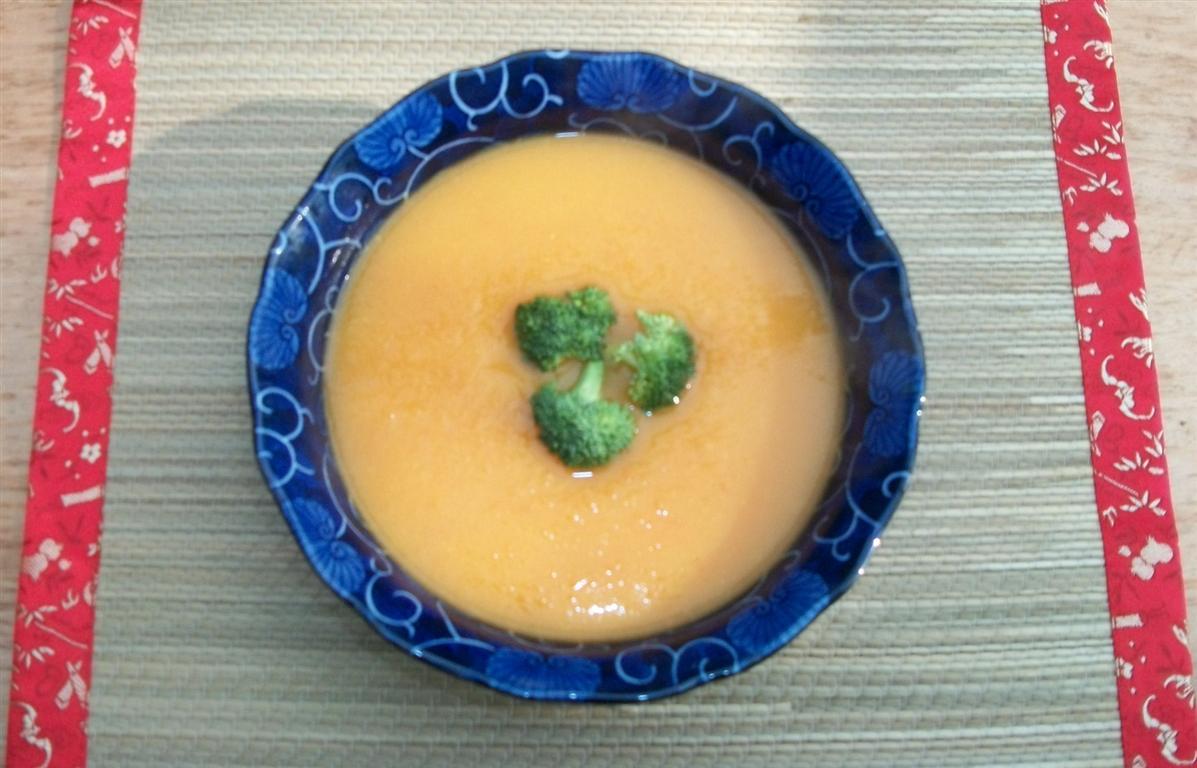
Preparation
Put all the ingredients in a big pot and add water to just cover the vegetables. Bring to a boil, cover and simmer until all the vegetables are soft, about ½ hour. With an electric hand blender or a food processor puree the vegetables, then return to a boil and add enough sea salt to taste, simmer 15 more minutes and serve hot with a garnish.
Brown Rice with Chestnuts
Ingredients
- 2 cups of brown rice, soaked overnight
- 10 to 15 dry chestnuts,
soaked overnight and cleaned - 4 cups spring water
- ½ tsp sea salt
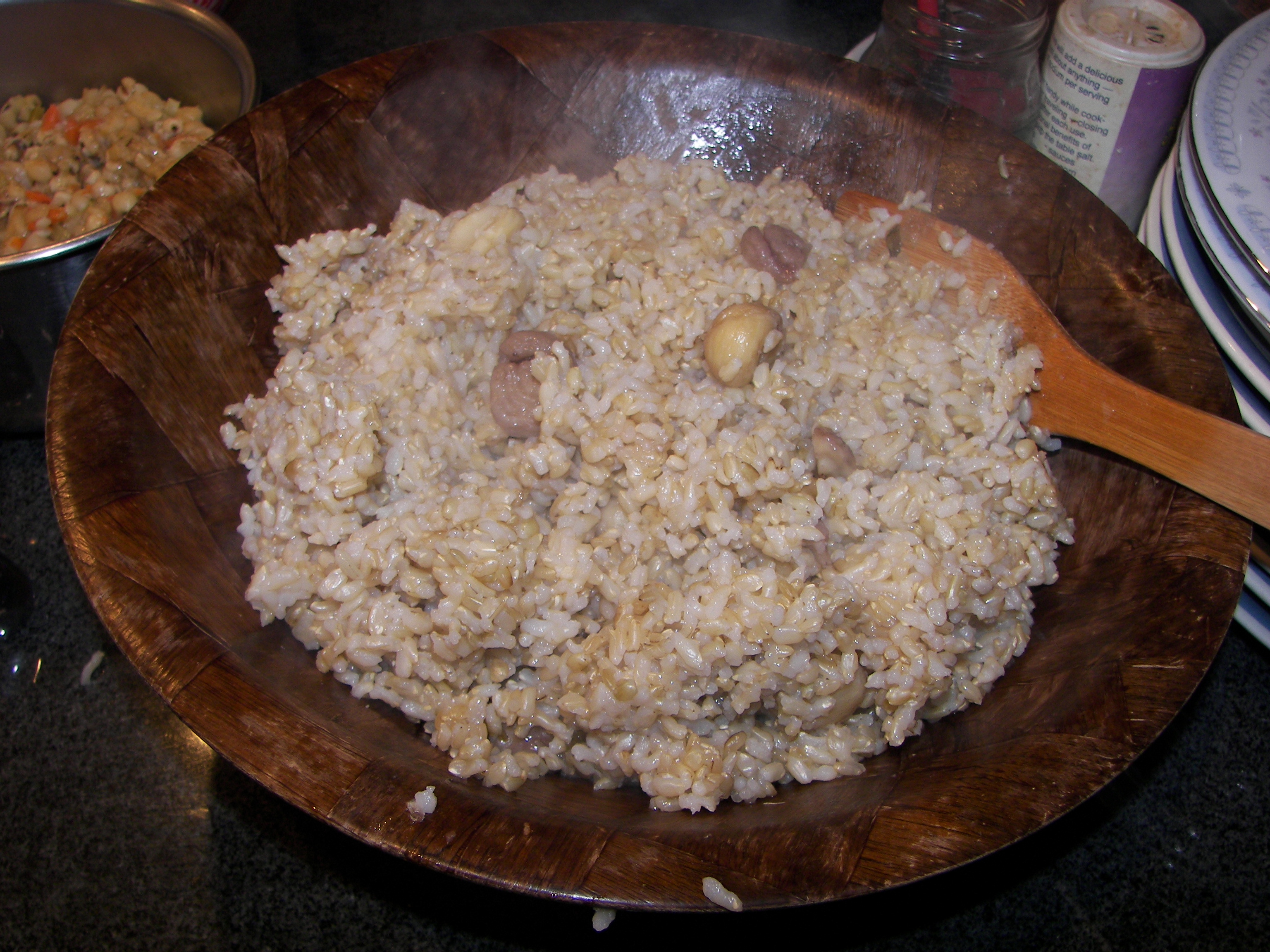
Preparation
Place all the ingredients into a pressure cooker. Bring to high steam and then simmer for 45 or 50 minutes. Remove cooker from the heat and allow the pressure drop. Serve the rice in a wooden bowl.
Soy Beans
Ingredients
- 2 cups yellow soybeans, soaked overnight
- 1 celery stalk, sliced
- 1 carrot, cubed
- 1 piece burdock, sliced thin
- 1 dry shittake mushroom, soaked and sliced thin
- 2" piece of Kombu, soaked and sliced thin
- 1 ½ Tbsp Tamari soy sauce
- 2 tsps kuzu or arrowroot
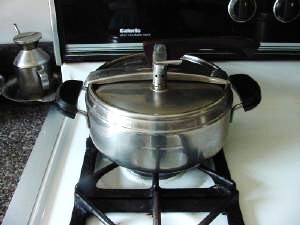
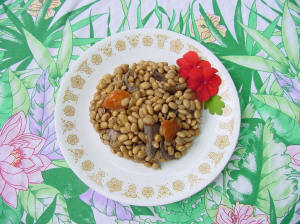
Preparation
Place the beans and the soaking water into a pressure cooker. Boil the beans uncovered for 15 minutes. Use a big spoon to skim all the hulls that separate from the beans and are floating. Cover with lid and bring the cooker to pressure. Cook for ½ hour on a low flame. Remove from heat, reduce pressure, open the lid and add kombu, celery, carrot, and mushroom. Cover again and bring back to pressure. Cook for 15 more minutes. Reduce pressure, open lid and add tamari soy sauce. On the side, dilute kuzu with a tablespoon cold water, liquefy by stirring it with a spoon and add to the beans while stirring constantly with a wooden spoon until the beans look creamy. The soybeans cooked this way are very tender and sweet tasting.
Carrots, Burdock and Lotus Roots Kimpira
Ingredients
- 1 carrot, cut in matchsticks
- 1 9" piece of Burdock, cut in matchsticks
- 1 small Lotus Root, cut in matchsticks
- 1 Tbsp toasted sesame oil
- Soy Sauce
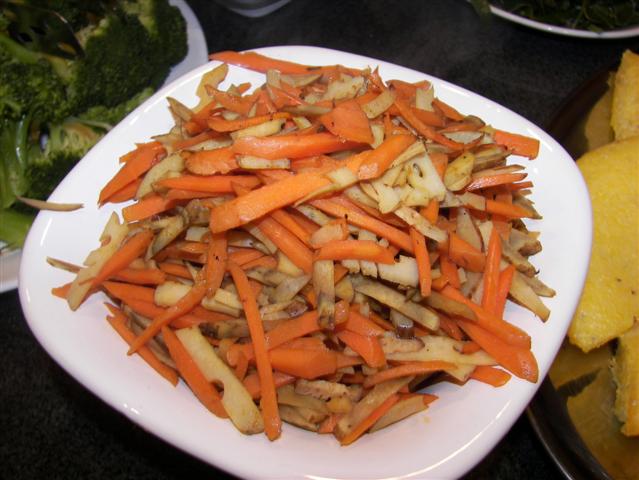
Preparation
Heat oil in a skillet over high flame. Add carrots, stirring constantly to prevent sticking and cook for 2 to 3 minutes. Add lotus roots and continue stirring, If it sticks on the bottom, add a few drops of water and continue stirring for 2 to 3 minutes. Add burdock and stir for a few more minutes. Add soy sauce and cook for another minute. Remove from heat. Serve.
Steamed Chinese Broccoli
Ingredients
- A bunch of fresh Chinese Broccoli,
washed and chopped - A steamer basket
- Tamari soy sauce

Preparation
First steam the stems for a few minutes until not quite tender. Add the leaves and steam 2 minutes. Add soy sauce and cook for another minute. Mix and serve.
Poetry
AUTUMN
